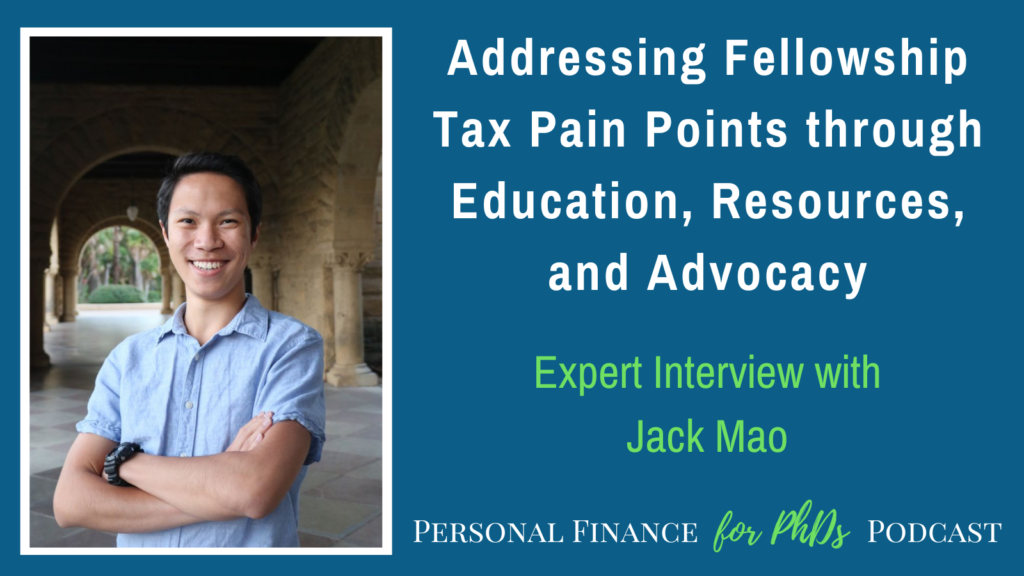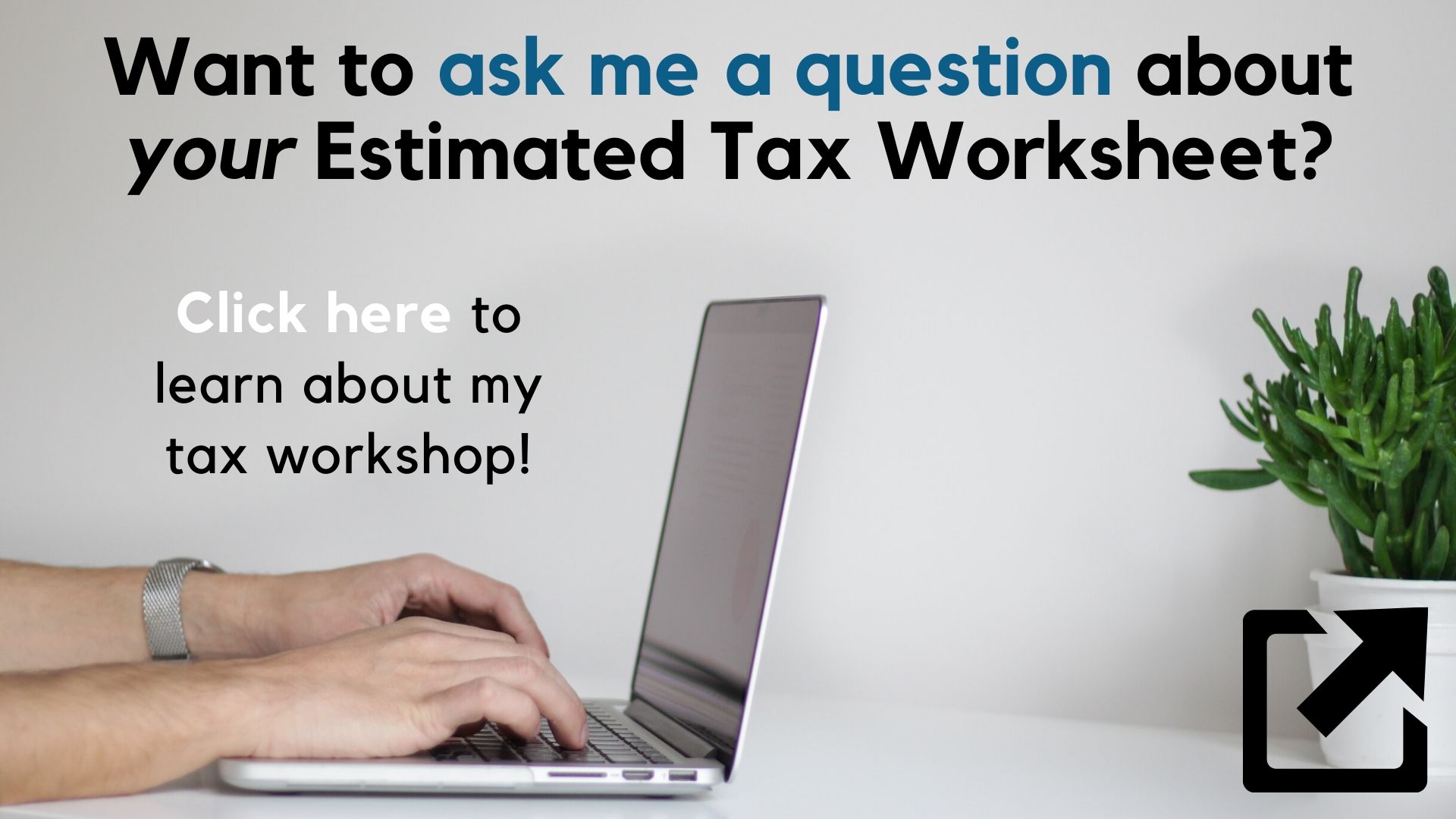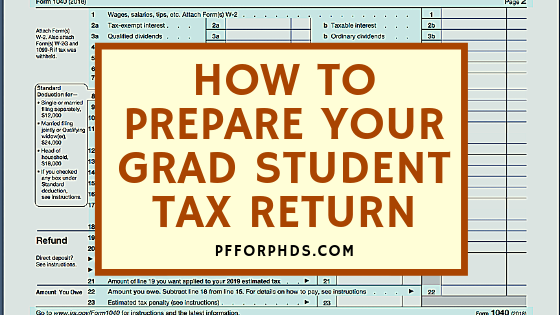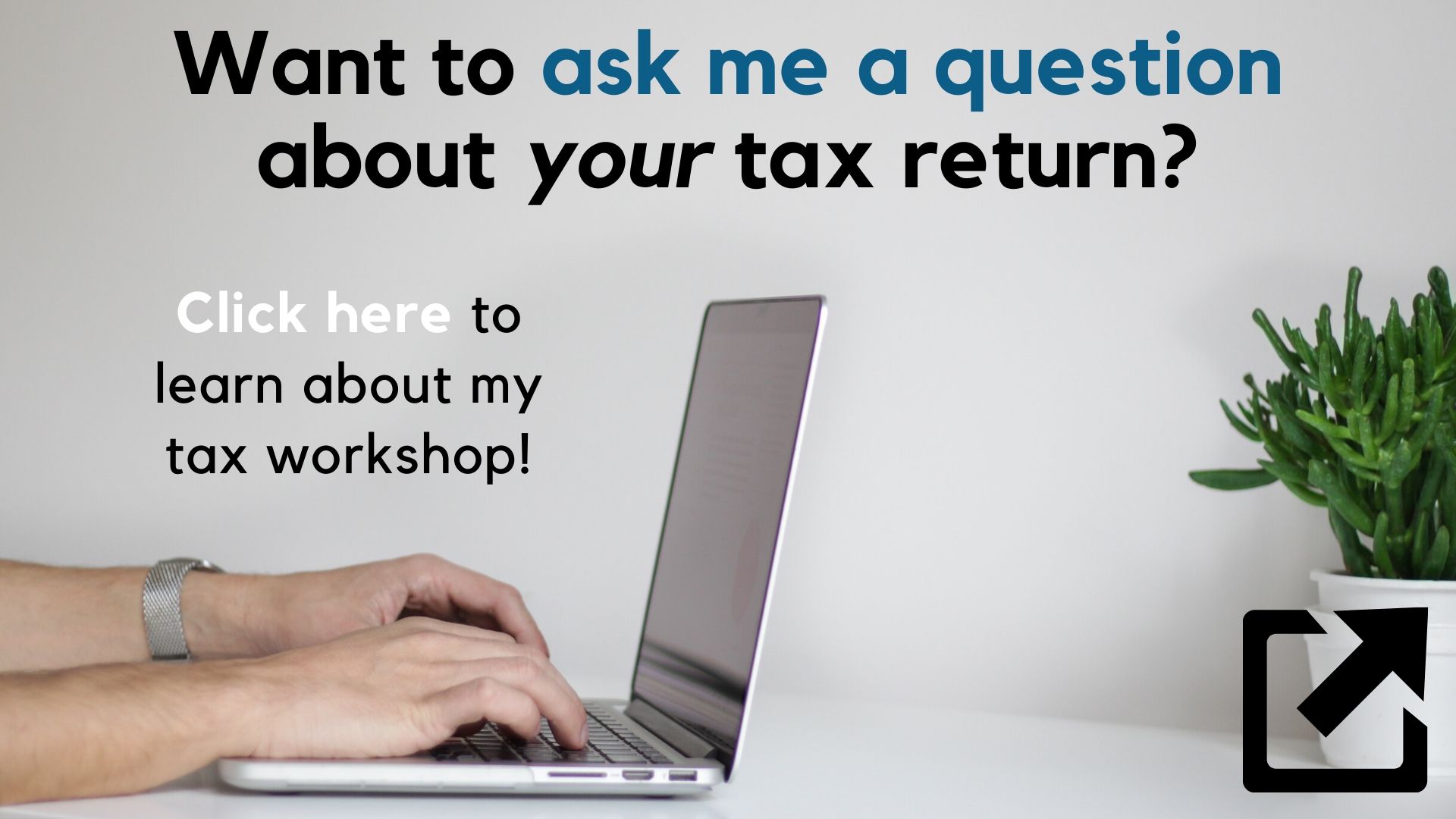In this episode, Emily interviews Hannah Cole, an artist and the founder of Sunlight Tax. Sunlight Tax primarily serves artists and creatives in their business tax needs, but there are many overlaps between artists and the academic community. Hannah and Emily discuss the best practices and insights that graduate students, postdocs, and PhDs with side businesses need to stay on the IRS’s good side. Hannah clarifies exactly when a business starts, the first step you must take with your finances, and how to calculate and pay your additional tax liability.
Links mentioned in the Episode
- Host a PF for PhDs Seminar at Your Institution
- Emily’s E-mail Address
- PF for PhDs Subscribe to Mailing List
- PF for PhDs Podcast Hub
- Hannah Cole’s Sunlight Podcast Episode: The Right Step at the Right Time
- Hannah Cole’s Website: Sunlight Tax
- Hannah Cole’s Free Course: New Rule for LLCs Free Course

Teaser
Hannah (00:00): You know, we have a whole tax industry out there trying to, you know, its marketing is based around making us all hate and fear our taxes and actually kind of implicitly training us not to even look at it, to just feel so fearful. And so, like, hands off that we don’t even look at it. And I’m just here to say I hate that. I disagree with it.
Introduction
Emily (00:29): Welcome to the Personal Finance for PhDs Podcast: A Higher Education in Personal Finance. This podcast is for PhDs and PhDs-to-be who want to explore the hidden curriculum of finances to learn the best practices for money management, career advancement, and advocacy for yourself and others. I’m your host, Dr. Emily Roberts, a financial educator specializing in early-career PhDs and founder of Personal Finance for PhDs.
Emily (00:58): This is Season 19, Episode 3, and today my guest is Hannah Cole, an artist and the founder of Sunlight Tax. Sunlight Tax primarily serves artists and creatives in their business tax needs, but there are many overlaps between artists and the academic community. Hannah and I discuss the best practices and insights that graduate students, postdocs, and PhDs with side businesses need to stay on the IRS’s good side. Hannah clarifies exactly when a business starts, the first step you must take with your finances, and how to calculate and pay your additional tax liability. This whole episode is devoted to business taxes, but before we get started I want to ask you if you or your peers need help figuring out taxes on your academic income, your graduate student stipend or postdoc salary and the attendant benefits. Now is actually the best time to start the conversation with your graduate school, postdoc office, graduate student association, etc. about bringing my tax content to your university in the upcoming tax season—so that they have time to plan their budgets. In this upcoming tax season I’m offering live workshops that I will tailor to your university and state and also pre-recorded workshops that are widely applicable. I would be very grateful if you would issue a recommendation to a potentially appropriate host at your university. You can find links to more information from PFforPhDs.com/financial-education/. Thank you! You can find the show notes for this episode at PFforPhDs.com/s19e3/. Without further ado, here’s my interview with Hannah Cole of Sunlight Tax.
Will You Please Introduce Yourself Further?
Emily (02:56): I have a really special guest on the podcast today, Hannah Cole of Sunlight Tax. I have been listening to Hannah’s podcast, Sunlight, the Sunlight podcast for, I don’t know, definitely more than a year now, maybe closer to two. And she is an amazing, uh, podcaster and practitioner in her field because she teaches about taxes to her community. I’m gonna have her introduce her community to you, but I see a lot of overlap between Hannah’s community and our community of academics and PhDs and graduate students and so forth. So Hannah is really gonna be able to bring her insight into taxes and specifically self-employment taxes to our conversation today. Um, which is going to focus on self-employment situations that grad students and postdocs are typically in, which is like a self-employment side hustle. So Hannah, thank you so much for agreeing to come on the podcast. I’m really excited. Will you please introduce yourself a little bit further for our audience.
Hannah (03:48): Sure. Um, thank you so much, Emily. I appreciate it. Um, yeah, so I am an artist first. I, I went and got my MFA in painting. Um, and I have a degree in art history and, uh, started my life as a professional artist and was so upset at how I was treated by the world of accounting <laugh> by my dad’s accountant that eventually I, you know, went out to get the information on my own. I went all the way back to school for accounting and studied taxes. Um, ’cause I live with a, you know, artists are solitary creatures. You know, you, when you’re a painter like me, you’re in the studio for long, long hours alone. And the only way to build your career is through a network. So, you know, we are like, uh, super networkers and my community of artists was deeply in need of the same information that I was. And I, I like, knew there was a need out there, and I was like, I’m so upset by the way that this has been delivered to me, if at all. Um, there’s, there’s a market here. Um, so I started my business Sunlight Tax. Um, and that’s my mission is to, it’s much, it’s much bigger of an audience than just creative people, but it is really kind of for people who maybe where money is not the sole interest that they have when they do the thing they do. Right. And I think as academics, you can probably relate to that because most people who go into academics have a passion for their field. Right. They’re trying to do some research, and that probably is a little bit primary over money. And so, you know, that’s very similar to artists that’s very similar to sort of mission-driven people. So it’s kind of a big group of people where money is not the only thing, but these people need to do their taxes too.
Similarities Between Academics and Creatives
Emily (05:37): Yes. I see so much of an overlap between how you described your journey to what you do today, uh, in the tax world, at any rate, and what I do with, uh, as being a financial educator. Yeah. Um, I love you sort of got started comparing the community that you come from the artist community with the academic community. I totally agree about those, um, overlaps. Are there any, would you like to elaborate on that in any way? Specifically? I’m thinking of are there like mindsets or like skills that you’ve observed or perhaps lack of skills among your community, um, perhaps that overlap with ours that either are, um, helpful or not so helpful when it comes to running a business, which some academics end up doing.
Hannah (06:16): Yeah. Well, I’m, the, the world of academia is not foreign to me. I mean, I taught, I was a professor, uh, at Boston University for a brief moment, <laugh> before I realized that I, I, uh, the, the strictures of academia were not, not for me. I think for people like us, when you’re, when your identity is formed around a passion for a thing, um, money can become the enemy by accident. Not really on purpose usually. But I think, um, I see a parallel between people in creative fields where, you know, there’s no artist in the world who’s gonna tell you that they do anything except make the best possible art they can. Right. And I think the same is true in academia. You’re gonna do the best, highest quality research you possibly can. You’re gonna, you know, whether that’s the most innovative or, you know, you’ve got the best ideas, the best protocols, whatever, however you’re doing it. And I think when that’s the case, you can kind of lose, you know, what you focus on is what does well, and if your focus comes off of money, too much money can get, uh, it can atrophy, right? Your skills in it can atrophy. Um, when your attention is not there, you just, uh, it can kind of get away from you. Right? And so I think that that is a sort of similar issue that, um, people in academia have to people in the creative world. Um, and I think just, you know, we’re busy, right? We’re busy doing the thing, we’re doing <laugh>, and this is one of the reasons I didn’t wanna be in academia ’cause of how busy you get <laugh>. Like, I was like, I, I’m never gonna be in the studio again if I do this. Um, and, and you just, it’s hard to check like, you know, self-employment, you know, when you’re talking about like grant income or the types of income that, that we’re talking about here, like track doing, doing, setting up bookkeeping, paying estimated quarterly taxes, like things like that. You know, they are a little bit complex and they do require some ongoing attention. So that’s, that’s a challenge.
Emily (08:23): Totally agree with everything you just said. Underline that. Um, in addition, I wonder if you could speak to, because I think another commonality between these communities is a percep- a perception among ourselves that our work is undervalued by other people and then we end up undervaluing ourselves in some cases, um, which is really dangerous when it comes to business ownership
Hannah (08:45): Very much. Yeah. And I think it’s, it, it’s easy to get into a mindset like that, especially if people around you in your daily life have a mindset like that. You tend to absorb the attitudes of the people you are with all day. Um, and so yeah, if you have people around you who feel like, uh, you know, the good ideas are over here and the money is over here and they’re in opposite directions, you’re gonna start getting outta balance where with, where money is in your life, like, I, I like to think of it this way, that money is neutral, right? Money is a tool. It’s like a hammer. You can do good things with it. You can do bad things with it, right? Like it’s amplifying the power of the person who has it. So if you’re doing good work, if you’re an ethical person, you can do amazing things and you can do more of them when you have more money. I don’t know. Think, um, think Oprah, think, um, Dolly Parton, you know, these are people who have great amounts of wealth and who do truly world changing wonderful things with their money, right? Uh, we could also probably think of quite a few examples of people who do not so great things with their money <laugh>. But I think the problem is when you go from thinking of money as neutral, right? Money as just being an amplifier of your agency to being negative, that that’s where you start getting problems. You start getting in a sort of stuck space around it. Because if you think of money as negative, or if you think that somehow your motives or ethics will be corrupted, if you simply have money more of this tool, you won’t advocate for yourself properly, right? Um, you cannot walk into a job interview and really nail it, um, nail the salary negotiation part of it specifically. Um, you’re not gonna advocate the way with the fierceness in that interview that you would if you believed that money was good, right? Or, or money in your hands was a good thing. If you fundamentally think, you know, having a fully funded retirement is makes you kind of a yucky person, you’re not gonna ever fund your retirement. You know, these things are related.
How Do You Know When You’ve Actually Started a Business?
Emily (10:55): Mm-Hmm. That is so interesting. I’m really, I really like the way you put that. I haven’t thought about it quite that way before. So thank you so much. Um, okay. I wanna narrow down to talking about like business ownership for, again, my community, which has many similarities with yours. Uh, they’re gonna be doing this as a, we’re gonna say a side income though, right? They have their primary thing as being a graduate student or being a postdoc, and they’re pursuing that, but they have a self-employment side hustle as well. Oftentimes what I see is people acting as like consultants, for example. Um, or maybe they’re a writer or an editor in, in this kind of world. So these, these kinds of side hustles, whether maybe, or data science. They’re employing some skills perhaps that they have developed as an academic, but outside of that academic context as a business owner. So, and I love that you’ve talked about this extensively on your podcast, but the question to you is how does someone know when they’ve actually started a business? Because especially when it’s something on the side, it may be a little vague at first.
Hannah (11:50): Yeah. This gets really confusing if you start thinking of the other organizations that think of your business start time as different. Um, and I, I do have a whole podcast episode about specifically when each one thinks you start. Um, so if you want me to, you know, link to that in your show notes, I would be happy to send that link. Um, but, you know, that’s on the Sunlight podcast. So to the IRS and this, you know, I’m a tax person, so I’m orienting towards that. When it comes to when you report the income, when you report the expenses, um, to the IRS, your, your business begins the moment you advertise. And that actually makes a lot of sense if you understand what makes you a business. The IRS says that you’re a business versus being a hobby. Um, so your side hustle is a business and not a hobby. If you have a profit motive, if you are trying to make money with it, right? It doesn’t mean that money has to be, you know, you worship at the altar of money and there’s nothing else in your life and you throw all your ethics and your, you know, value and, and your amazing work out the window. Not that, but it has to be in there, has to be in the mix, and it has to be, you know, strong. Um, and so if you think about that, having an intent to make a profit, which is the IRS definition of you being a business that happens before you make a profit, that happens before you make money. And I think this is where people get confused. They think, I I, I, I only get to report it once I’m making money, but actually no, because you start that business with expenses, right? You have expenses first. Then once you’ve built something, um, let’s use an example of like a pizzeria. ’cause it’s very tangible and we’ve all been to one. Um, you don’t start generating income from that pizzeria day one, right? The pizzeria has to exist first. Like, you can’t sell a slice of pizza if you don’t have an oven <laugh>. You have to install the oven, you have to have a bakery, you have to have flour, right? So you’re gonna have a lot of expenses before you ever can even bring a dollar in the door. And I think it’s really important to get your head around that concept. You are not broken because that’s how your business is working. That’s actually normal, right? And we have in business school, they teach this concept called the break even point. Well, what is that? The break even point is the magical moment when you go from negative income, AKA, AKA spending <laugh> and, and, um, it’s that magical moment when you go from negative income to zero, right? And then over the zero, then the number starts getting positive. That’s the moment you become profitable, right? When your, when your income rises above the amount of your expenses for the first time, and you know what, there is no guarantee or promise that that will ever happen or that it will happen on a certain timeline. That’s all within your control and your profit motive should be driving that bus. But, uh, it’s, it’s good to know that it’s normal to have expenses first. And in fact, you’re entitled to file a Schedule C that is where you put this stuff on your tax return. You’re entitled to file one before you have a profit. So the title of the Schedule C is profit or loss from business. So one, you have to be a business, it’s in the title, but also you don’t have to have a profit that’s also in the title. So that’s kind of a good baseline. So remember, the moment you advertise, and if you think about it is, is the moment that you start that your business starts. And if you think about it, that makes sense. ’cause advertising says hello world, hello clients, I’m open, I have this thing available. If you’re the right person, if this will work for you, come and get it. Right? But also, you know, to somebody who is, let’s say, doing some freelance editing on the side, advertising is not gonna look the way it does for Coca-Cola, right? Advertising for you is probably gonna be an email to a couple of friends and family. You’re still advertising. You probably aren’t thinking of that as advertising, but whatever you do that’s signaling, Hey, hey, I do this thing, are you interested? So maybe that’s an Instagram post. Maybe it’s an email to friends and family. Um, maybe it’s a website going live. Those are all your moment when you started advertising.
Emily (16:14): I’m so glad you gave that example because as I said earlier, I see a lot of like service-based businesses as side hustles, um, for this community. And so just when you were describing that, I was like, yeah, if you put something up on LinkedIn, if you put your services out there on, um, whatever the current version of Upwork is, um, or like you said, an email to a friend putting up a website, Hey, it costs money to host a website. So like, you’re probably having your first expense when you do that. Um, or maybe you’re starting to pay for software to like get client scheduling set up or whatever it might be. Um, I think part of the confusion when people are asking this question is they think somehow it’s like a, a bad or like an onerous thing to be considered a business and have the attendant tax filing, uh, requirements along with it.
Emily (16:57): But what I really learned from your podcast and your attitude around it is no, this is a great thing to be considered a business, especially as you were just saying, when it takes some time to get to that turning point where you actually have profit. So like, if you have a whole year when you have some, some loss, even though you’ve started advertising, maybe you have some expenses, the income isn’t there yet. Um, you can use that to reduce your tax liability, actually. And so it’s not, it’s not a bad thing to be considered a business earlier. It does have some complications, but it’s, it’s, it’s actually a very positive thing to realize that you have a business
Hannah (17:29): Very much. I mean, and it, it tangibly lowers your taxes. <laugh>. I mean, we in this country are supporting business not out of a charitable purpose, but because it’s good for the u- US economy, right? Like when we support us small businesses and, and we count, you and me, Emily, we count <laugh>. Um, when you support a small business, you are, you are helping the US GDP grow, right? That’s in the interest of the nation we live in. Um, ultimately, you know, you’re gonna spend a lot of money, you get business deduction, you get business expenses, they are deductible on your tax return. That’s a incredible benefit given to you by Uncle Sam. I mean, I, I don’t think we all appreciate that quite as much as we should. Um, but that’s, that’s huge. Um, and yeah, and so you’re, you’re getting this subsidy <laugh> and it’s nice to take advantage of. It’s nice to know what your rights are and take advantage of it. Um, and of course, if you weren’t a business, if you were operating as a hobby, instead you wouldn’t get those deductions. So there’s a real difference.
Emily (18:38): Yeah. Thank you.
Commercial
Emily (18:41): Emily here for a brief interlude. Would you like to learn directly from me on a personal finance topic, such as taxes, budgeting, investing, and goal-setting, each tailored specifically for graduate students and postdocs? I offer workshops on these topics and more in a variety of formats, and I’m now booking for the 2024-2025 academic year. If you would like to bring my content to your institution, would you please recommend me as a speaker or facilitator to your university, graduate school, graduate student association, or postdoc office? My seminars are usually slated as professional development or personal wellness. Ask the potential host to go to PFforPhDs.com/financial-education/ or simply email me at [email protected] to start the process. I really appreciate these recommendations, which are the best way for me to start a conversation with a potential host. The paid work I do with universities and institutes enables me to keep producing this podcast and all my other free resources. Thank you in advance if you decide to issue a recommendation! Now back to our interview.
Best Financial Practices for Early Career Academics With Businesses
Emily (19:59): Okay. So I’m thinking still about this grad student or postdoc or early career PhD who’s, has this business now they know they’re starting it on the side. What are some best practices that they should implement in their finances from day one to make things easier or like totally above board going forward?
Hannah (20:16): Sure. Um, the first is to open a separate bank account. Um, you wanna keep your business income and expenses separated from your personal bank account and personal expenses. Um, there’s many reasons why this is a good idea. All of it is a good idea. <laugh>, there is no negative, um, except that you have to go through the effort of opening an account. Um, but the magic that that separation does is now when you have that business bank account and you deposit all the money you earn from that freelance side hustle, you know, that gig, whatever it is, now you are creating a record of everything into and out of your business. That record becomes the backbone of your bookkeeping. So now from there, setting up bookkeeping, setting up tracking becomes far simpler. Um, Emily, when I started out as a professional artist, before I knew to do all this stuff, I was printing out bank statements going through, you know, like three days before tax time, going through my bank statement, line by line with a highlighter, trying to, trying to recall if that trip I made back in February last year to Lowe’s was for business or for my home, right? <laugh>, Like we don’t want that <laugh>. If you have a dedicated business account and you keep a mindset of I only spend this money on business expenses, then everything in there is deductible. You just have to sort out what category of deduction it goes into. So man, it makes your life simple. And then, you know, once your business grows, this is a thing that grows with you. Um, you can automate that bank feed into bookkeeping software. That’s a next step thing. You don’t have to do that day one, but it gives you the, you know, the easy option. Um, also if you one day create an LLC for liability protection, your LLC will be instantly invalidated if you don’t have a separate business bank account, you, when you have a liability, uh, limited liability corporation, the whole thing you’ve done legally is to separate your business and personal selves. And if you then don’t actually do it in the background, a court of law can say you don’t have an LLC, you don’t have any liability protection, and basically your LLC is thrown out, you’ve wasted all that money. Um, so <laugh>, there’s no downside, in other words, to a business bank account. PS it doesn’t actually have to be technically a business account according to your bank’s rules. It can just be a personal account. That’s another separate account. It’s the separation that’s important. So it can be, you know, technically a personal account according to the bank. That’s fine. Just use it like it’s your business account.
Emily (23:05): Thank you so much for that. Um, that clarification, and actually you threw out a couple of terms there. So I just want to, this is partially some things I’ve learned from you, clarify for the listener. Um, this, this term LLC, the limited liability company, this is a legal status and it’s not, it doesn’t necessarily confer a specific tax status. So when you’re first starting out out, when you’re first starting out with a, a side business or something, you’re likely gonna be operating as a sole proprietor. Then maybe for the entire lifetime of the business, you’ll be a sole proprietor. Whether or not you open an LLC as well, your tax status will stay a sole proprietor. That is, unless you decide that you want to grow your business to the point where becoming a different kind of tax status would make sense, like an S selection, et cetera. But for people who keep businesses on the side, I would imagine many of them continue to operate as sole proprietors indefinitely.
Hannah (23:55): Yep. I would say that’s probably true. Yeah.
Preparing for Tax Season as a Business Owner
Emily (23:58): So you just mentioned this core first step, which is to open a separate bank account, and I totally agree with it. You know, when I first started out my very first side hustle, I didn’t have that, but I knew by the time I started this business that it was important. So that was the first thing that I did when I started this, um, this business, even though I’ve been a sole proprietor the whole time as we were just talking about. So is there anything else that someone should do, um, like at this point in the year, you know, we’re sitting in September when we’re recording this. Is there anyone, anything that, uh, business owners should do outside of their actions during tax season to set themselves up to, you know, prepare a tax to return easily to minimize their tax liability beyond this core, as you said, the backbone of having a separate account?
Hannah (24:39): I mean, there’s a whole world of year-end tax planning. I would say independent of year-end tax planning, which is coming up, we are coming upon that time of year. But independent of that, I would say from your separate business bank account, just setting up some basic bookkeeping is a good idea. Having the separate bank account isn’t bookkeeping itself, though. It forms a basis for it. So if you don’t love the idea of like sitting with your bank statements and pulling everything into a category, you know, before tax time, doing that in advance is quite nice and quite helpful. <laugh>. And I actually think if it’s at the level of a gig or a side hustle, I actually think you don’t need bookkeeping software at all. I think bookkeeping software, if I’m just being totally honest with you, it’s very easy to make very expensive mistakes that compound and, uh, that you can only get undone with very expensive accounting help. Um, so I actually don’t really think people with very, very small like side hustle level businesses maybe even should have software for bookkeeping at all. Um, but that doesn’t mean you do bookkeeping. You can just do it on a spreadsheet. So have a spreadsheet, lay out your expense categories, track your income, and just do the tallies. Um, because knowing if that will help, you know, in an ongoing way if you’re profitable or not, which is a, a big deal, it’s also what your taxes are based on. So, um, paying estimated quarterly taxes, for example, if you need to, is only going to be possible when you know what the number is, <laugh>. Um, so you wanna be able to know what your profit was for the quarter. So you can do a little calculation about what percentage of that you need to pay to the IRS and to your state for taxes.
Side Hustles and Estimated Tax
Emily (26:29): This is a little bit nuanced. Um, what I’d like to specifically talk about is how to like sort of add the estimated tax process on top of an existing salary, right? Because this is a side hustle business, so. What would you tell someone who’s, uh, who has that situation, how they should handle their estimated tax?
Hannah (26:50): Yeah, I might tell them to avoid it altogether. Um, honestly, because human behavior being what it is, estimated taxes are manual. You have to do the calculation, you have to make the payment. And we just know from data, you know, from behavioral science that people don’t do things like the, they do the default more often than not. So if you can default your taxes, that’s what you wanna do. So if you’re in the side hustle zone, the thing you wanna understand is that your taxes are holistic. They are all of your income lumped together and your spouses lumped all together and put onto one tax return with one number of what you owe, or you know, what you got a refund for if you overpaid. So if three quarters of your income comes from a job, you know, where you’re an employee and you have payroll withholding your taxes throughout the year, and one quarter of your income is coming from this gig or side hustle, you have enough proportionally money that you could take out of your W2 to never have to pay quarterly taxes. But what you need to do, the action you do need to take is to file a new W four with your employer to adjust your withholding at your day job to over withhold. In other words, you don’t wanna withhold only enough taxes to cover the tax obligation formed by the employment. You wanna overdo it and go into taking enough taxes to account for your self-employment. Um, your gig, your side hustle income that is considered self-employment income. FYI, um, and the taxes on that are always higher than you think because self-employment tax applies to self-employed income. So your employer is paying one half of that amount. It’s one of your wonderful benefits as an employee. You pay both halves when you’re self-employed because you legit are the boss <laugh>. You pay the employee and the boss half of Medicare and social security. And we call that self-employment tax. So my tip there is pull a W 4 off the internet, go to irs.gov, grab yourself a W 4, fill it out. You might need some old pay stubs. You might want last year’s tax return. If you have any bookkeeping from your business year to date, that’s great. Um, or just last year’s tax return. Um, hopefully if that gig was going already last year. And then you just wanna fill out the little, um, paycheck checkup tool on the IRS website that will help you, um, adjust your withholding to essentially give you, you know, the refund level that you wanna have. Um, I recommend zero <laugh>
Emily (29:34): I, it’s the same way I would approach things. That’s how I also teach. Um, anyone, anyone who has a fellowship income, which does not have withholding on it, but who also has W2 income, their spouse or them, that’s the same thing. I say, make this easier on yourself, just fill out a new W 4. But let’s add the added wrinkle of they don’t have the W2 position. Let’s say they’re receiving a fellowship, it already doesn’t have tax withholding on it. Maybe they’re already doing estimated tax because they have that fellowship. Um mm-Hmm. How should they incorporate the self, the self-employed income and, and the income and the self-employment tax from that, um, in with their ongoing like fellowship type income, uh, calculations?
Hannah (30:12): Yeah, well they’re gonna, you’re gonna need to do some degree of bookkeeping or else it’s gonna be a very stressful moment before the tax deadline. Um, and you will, you know, you’ll need to pay quarterly taxes every single quarter that that’s your legal obligation. So under US tax law, if on last year’s tax return you owed more than a thousand dollars, then you have to pay quarterly taxes this year or else you’ll get penalties and interest. Um, and you can pull out last year’s tax return and you can check if you’re in this category. So line 37 of your 1040 personal income tax return is gonna tell you what you owed last year. And if you see a number on there and it’s greater than a thousand, you gotta be paying quarterly taxes this year. Um, PS line 38, the line just below that is your estimated tax penalty <laugh>. So you can look at that line to see if you’re already being punished for not doing this. Um, I think that people, you know, we have a whole tax industry out there trying to, you know, its marketing is based around making us all hate and fear our taxes and actually kind of implicitly training us not to even look at it to just feel so fearful. And so, like hands off that we don’t even look at it. And I’m just here to say, I hate that I disagree with it. Your taxes are yours. Your 1040 is your information and you can, you know, the first two pages of it summarize every single thing that is in that big tax packet. And if you just look at every line on the first two pages, you have massive power. You know what’s happening. Um, and I just told you two lines, the power in those two lines, line 37 and line 38 and that, you know, that will, that will help you kind of get your head around <laugh> whether you have to pay quarterly or not. If you do, um, you know, if you think about what line 37 tax, you know, what you owe, like owing something at tax time is not supposed to happen, right? It does happen. It’s okay. It’s a reconciliation document where we reconcile the actual amount paid versus the expected amount, um, and we settle up the difference. But essentially owing anything means you underpaid your taxes throughout the year. ’cause we live in a pay as you go tax system. You’re supposed to pay your taxes as you go through the year, not all on April 15th.
Emily (32:40): I think what I would say, in addition to what you just said, um, the, the form form 1040, ES, the estimated tax worksheet is a very helpful document in calculating your estimated tax due. Um, people in the audience listening may already be familiar with this for their fellowship income, but you just have to add in a few more lines relevant to the business income and so forth. But if they don’t wanna do more calculations, I think I would tell them just to kind of, as a rule of thumb, set aside an additional 15.3% of their business profit. If there is a profit for that self-employment tax pay, that plus whatever their marginal tax rate is, let’s say it’s 12% usually for graduate students, maybe 22% for some postdocs. Um, if they’re single and just doing that much, if you don’t wanna do like a full calculation is gonna get you, that’s an 80 20 <laugh> on that is to add mm-hmm, that additional amount of money in with either your W 4 or your estimated tax payments if you’re doing it on your fellowship already. Um, but doing the detailed calculation is always gonna be the most, uh, thorough and the most accurate way to go. But Hannah, uh, when you were.
Hannah (33:46): Sure, although keep in, keep in mind ’cause it’s stressful for people. I think like especially if you’re coming to this and you’ve not learned about how estimated quarterly taxes work, um, it’s really important to remember the first word. It is an estimate and you’re not gonna know, like fundamentally you can look at your tax rate from last year, but last year’s tax rate does not guarantee this year’s tax rate, right? So even if you do it in good faith and you did the best possible job, you could, you can still be wrong. And so really, I just encourage you like 80 20 is a good attitude on this because it is called an estimate because you don’t have a crystal ball, like the law cannot compel you to accurately predict a future. So we can all just breathe a sigh of relief and just estimate and that’s okay.
Emily (34:35): The other good thing about paying those quarterly taxes, um, as you go, as you were saying is that, um, there’s never gonna be such a huge balance built up. Like something that often happens in our community with fellowship income is that people get to tax season and they realize they owe three, four, $5,000 because they never paid estimated tax or had tax withholding during the year. And that is a huge shock on like this level of income that we’re talking about. And it can happen with business income too, um, especially if you’re taking distributions from your business and then you’re spending that money. Um, so either keep the money in your business account and don’t take the distributions or as you take the distributions, make sure you’re putting aside something for either your quarterly or your annual tax bill so it doesn’t, doesn’t get away from you <laugh>.
Hannah (35:17): Absolutely. Yeah.
Sunlight Tax and the Sunlight Podcast
Emily (35:19): So just a few minutes ago when you were talking about how, um, you know, our, our system, mostly the tax industry that’s built up around our regulations, they want you to feel a certain way about taxes and in fact you should be empowered about this, et cetera, et cetera. This is a taste of what people can get on your podcast. So I would love you to take a minute and just tell everybody where they can find you, what you put out there, what you do in your business, and if they want to learn more from you or work with you in some way, how they can do that.
Hannah (35:46): Sure. Thanks Emily. Um, well, so my business is Sunlight Tax. If you go to sunlighttax.com, you’ll find everything there. So if you miss something, sunlighttax.com, I have my podcast, which comes out every Tuesday, Sunlight, um, you can find that on my website, sunlighttax.com. Um, I also have a bunch of free resources like, uh, deductions guide, a visual Guide to Tax Deductions, which you can also find on my website. Um, I offer a lot of free courses, including a recent one about, um, LLCs. If you go to sunlighttax.com/llc, if you happen to have formed an LLC for your side hustle or your business, um, there’s a mandatory, a mandatory new report required, um, from the US Treasury <laugh>. Um, but also I have a program called Money Bootcamp where I teach, um, people how to set up very simple systems to track your taxes, um, pay your estimates and fund your retirement using tax advantage accounts. So, um, all of that you can find @ sunlighttax.com and,
Emily (36:51): Excellent.
Hannah (36:51): Yeah.
Best Financial Advice for Another Early-Career PhD
Emily (36:52): Yes, and I will definitely personally vouch for the podcast because I am a listener every single week and I learn something new every week and I think it’s great. Um, okay, Hannah, I’m gonna end by asking you the question that I ask all my guests, which is, what is your best financial advice for an early career PhD? A grad student, a postdoc, someone recently out of their PhD training? Um, and that can be something that we’ve touched on already that’s related to tax, or it could be something completely aside from what we’ve discussed.
Hannah (37:19): Sure. Um, I’ll say this, it’s a bit of my personal religion, but, um, if you have never played with a compound interest calculator and seeing what the power of your money is when it is invested, um, please do yourself that favor, <laugh>. Um, and I would say do not just write yourself off. Say, I am broke right now. I will wait to put money in an IRA I really highly encourage you, if you do nothing else, maintaining an annual habit of maxing out your IRA will put you in a better position. Um, it, it will, you know, you invest the money inside the IRA so it will grow with compound interest and tax sheltered. So it’s really a wonderful thing that works when you start young <laugh>. You don’t wanna miss five years of compounding because you’re in grad school. Um, if you can, you know, just make it your religion to do it every single year without skipping, I think that is my best piece of advice. And believe you as a 45-year-old woman, woman, <laugh> talking to you, I, I wish for everyone here that we could all have started at the age that you are now. Um, and the age you are now is only it, you know, the best time to start this investments your investments was 20 years ago, but the second best time is now.
Emily (38:41): Love that advice. You touched on my two favorite topics today, taxes and investing. So it’s amazing. <laugh>. I will also just say, I mean, I love the goal of maxing out an IRA, but that’s not gonna be possible for many people. So even if it’s just, um, $50 a month, a hundred, 200, whatever you can do, be in the habit of it. And do as much as you can. And then absolutely, once you get that higher income from your lovely post-PhD job, then you can really ramp it up and use your 401k and use everything else. But having that habit of doing it from earlier and having sort of developing the identity of I am an investor and understanding things like compound interest that is gonna serve you so well later on, um, not just the dollars and the numbers, but all that psychology that comes along with it.
Hannah (39:24): Absolutely. Yeah. They, they show that even very, very poor people who have a savings account save more because just having it there helps you do it. So if you haven’t opened an IRA yet, I encourage you to do it this year. Even if it, even if you put 10 bucks in <laugh>, like open it. The fact that it’s there is setting up the infrastructure to make it easier to do that, you know, thing. And really saving, savings and investing is a muscle. So think of it as like a muscle that you have to get in some reps to get good at.
Emily (39:55): I love it. Hannah, thank you so much for joining me today. It’s been a wonderful episode and thanks again.
Hannah (40:02): Thanks so much, Emily. I really loved joining you today.
Outtro
Emily (40:15): Listeners, thank you for joining me for this episode! I have a gift for you! You know that final question I ask of all my guests regarding their best financial advice? My team has collected short summaries of all the answers ever given on the podcast into a document that is updated with each new episode release. You can gain access to it by registering for my mailing list at PFforPhDs.com/advice/. Would you like to access transcripts or videos of each episode? I link the show notes for each episode from PFforPhDs.com/podcast/. See you in the next episode, and remember: You don’t have to have a PhD to succeed with personal finance… but it helps! Nothing you hear on this podcast should be taken as financial, tax, or legal advice for any individual. The music is “Stages of Awakening” by Podington Bear from the Free Music Archive and is shared under CC by NC. Podcast editing by Dr. Lourdes Bobbio and show notes creation by Dr. Jill Hoffman.









